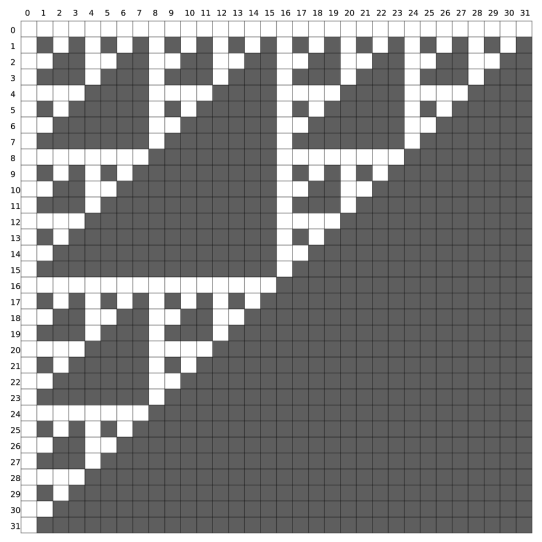COI '14 #1 Čvenk
View as PDFA group of Czech tourists is walking in a labyrinth of a strange self-similar shape. The ground plan of the labyrinth is a Sierpinski triangle – a fractal structure named after the Polish mathematician Wacław Sierpiński.
The labyrinth consists of a billion rows numbered from to
from top to bottom, and a billion columns
numbered from
to
from left to right. The fields in the labyrinth can be either free or blocked.
The field in row and column
is free if the result of the bitwise
and operation on the numbers and
is equal to zero, otherwise it is blocked. In other words, a field is blocked if, when
and
are switched
to binary, there is an integer
such that the
digit from the right of the number
and the
digit from
the right of the number
are equal to
.

The Czech tourists are tired from a long day of wandering and would like to meet up in a free field and exchange experiences. In each step, one tourist can jump to one of the adjacent free fields (up, down, left or right).
Write a programme that will, based on the current tourists' locations, determine the minimum total number of steps necessary in order for all the tourists to meet in the same field.
Input Specification
The first line of input contains an integer – the number of tourists. Each of the following
lines contains
two integers
and
– the row and column of the field where the
tourist is located.
All the tourists are located in free fields, and it is possible that there are multiple tourists in the same field.
Output Specification
The first and only line of output must contain the required minimum number of steps.
Please note: We recommend that you use a -bit integer data type (
int64 in Pascal, long long in C/C++).
Constraints
| Subtask | Score | Constraints |
|---|---|---|
Sample Input 1
2
2 1
4 3Sample Output 1
6Explanation for Sample Output 1
One of the fields where the brave Czech tourists could have met is .
Sample Input 2
6
2 5
3 4
8 7
9 6
10 5
11 4Sample Output 2
50Explanation for Sample Output 2
One of the fields where the playful Czech tourists could have met is .
Comments